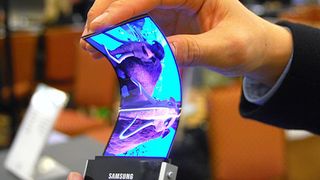Why we may not see the foldable Samsung Galaxy X any time soon
Exclusive: The technology is still far behind what's needed

One of the key questions in the Samsung Galaxy X story is when we're actually going to see a foldable phone from the brand - we've been expecting it to land for years now, but it looks like we could be waiting a little longer for this phone and other bendy devices from manufacturers.
In an exclusive interview with Salman Saeed, Qualcomm’s product manager of display technology, TechRadar was told we might not see the phone arrive as soon as recent rumors have teased.
In fact, it might be years until something along the lines of the foldable phone, like what we’ve seen in leaked Samsung patents, actually comes to fruition.
So, what’s holding things up? Beyond the fierce challenge of fine-tuning the user experience across multiple displays to justify their existence, durability continues to be the main issue.
"They [phone manufacturers] haven’t cracked the material science right now to produce electrodes that can repeatedly withstand bending and folding."
-Salman Saeed, Qualcomm
Specifically, Saeed points to the transistors in the display architecture as being the weakest link, pointing out that the components responsible for powering individual pixels “are not flexible enough today” to withstand frequent bending.
The pipedream for a foldable phone is for the display to continue along through the hinge seamlessly for a gap-free viewing experience. Unlike the ZTE Axon M seen below, future attempts at a bendable phones would ideally solve the issue of its illusion-shattering gap in the screen at its hinge.
But, while likely common knowledge among display engineers, Saeed shared that accomplishing such a feat will be difficult and that “they [phone manufacturers] haven’t really cracked the material science right now to produce electrodes that can repeatedly withstand bending and folding.”
Get daily insight, inspiration and deals in your inbox
Get the hottest deals available in your inbox plus news, reviews, opinion, analysis and more from the TechRadar team.


Delayed, but determined
Despite these setbacks, a future filled with wallet-style foldable phones isn’t a matter of if, but when. The ZTE Axon M from 2017 might not have been bought by reams of consumers, or even widely recognized, but Saeed stated it was an important step forward for foldable phones, both in proving the concept had a lot of potential and that it needed a lot of work.
“[The ZTE Axon M] looks a little ugly... the use cases are pretty bad. The second display does practically nothing, but I think it’s compelling.
“Rather than having a super large primary display, you could have a foldable phone that becomes an even larger display, so that if you’re doing some content creation, you have a larger surface area to work on.”
Creating a user experience that flows neatly between the screens will remain as fierce a challenge as building these devices, but Saeed and Qualcomm are optimistic.
“I think it’s possible for them to do it [bring foldable phones to market]... All of the tier 1 phone manufacturers are working very hard on this. The big phone makers all have these devices in their labs, but it’s just a reliability issue at this point.”
More for your money
It’s sometimes tough to find ways to best take advantage of high-end phone specs, and some of the horsepower goes unused. But whenever foldable smartphones do arrive, Saeed thinks that consumers will be able to get even more performance for their money.
“If you look at what Samsung has done with the Snapdragon 835 [speaking of the Samsung Galaxy S8] and DeX, our chipset can power two...three...four displays at the same time, so yeah, we’re underutilized right now. We have the GPU horsepower, we have everything needed to fully power all of those extra pixels.”
We’re ready for the foldable future and from the sound of it, so are the component manufacturers, with more power thrust into our flagship phones every year.
It’s not pleasing for anyone to see these exciting phones hit a snag in development, but if there’s one thing we can be thankful in their apparent delay, it’s that at least the Samsung Galaxy X shouldn’t break under pressure.
Though, whether it withstands to the tremendous hype is another question entirely.
Editor's note: This story, including the headline, has been updated following clarification from Qualcomm.
- Android P will be ready for foldable and notch-touting phones
Cameron is a writer at The Verge, focused on reviews, deals coverage, and news. He wrote for magazines and websites such as The Verge, TechRadar, Practical Photoshop, Polygon, Eater and Al Bawaba.
